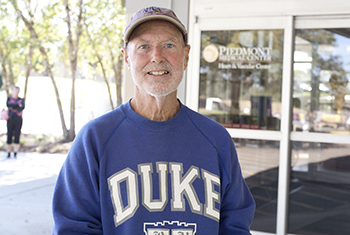Bob's Blood Cancer Story
Jun 6, 2019Robert “Bob” Paul, 69, returning heart and cancer patient
You can’t crawl in a hole. You can exercise, you can control your weight, take your medication - there are proactive things you can do.
 Bob Paul, 69, was first brought to Piedmont Medical Center in 2003 in an ambulance, and before he left, he had two stents in his heart. For the next 11 years, he saw his doctor every six months and got periodic stress tests. Everything seemed to be going fine.
Bob Paul, 69, was first brought to Piedmont Medical Center in 2003 in an ambulance, and before he left, he had two stents in his heart. For the next 11 years, he saw his doctor every six months and got periodic stress tests. Everything seemed to be going fine.
But in June 2014, there were some concerns. Looking further, his doctors discovered he had three arteries that were greater than 80 percent clogged. He needed immediate open-heart surgery.
“I was shocked because when I came in I wasn’t feeling bad,” he says. “I had no indication that I had a heart problem. So it kind of shocked me that they had found this when I had gone 11 years and all of the sudden the arteries were plugged and I didn’t really know it.”
He had followed all of the rules and worked on healthy living habits, many things he picked up in cardiac rehab, and he is glad his doctors at Piedmont were so vigilant with his follow-ups.
“I always tried to obey the eating guidelines for a heart-healthy diet,” he says. “I kept my weight down and my blood pressure. I did all of that and even with obeying all the rules, there are some genetic reasons or stress beyond eating that can cause heart disease.”
Bob admits he was scared heading into open-heart surgery, but the staff got him right up and walking around soon. He participated in cardiac rehab again, following any and all instructions so he could get back to living his full life.
A second diagnosis
In 2007, between Bob’s heart issues, he was diagnosed with multiple myeloma, an incurable blood cancer. Once a month, he goes to Piedmont for bloodwork and treatment, usually with his wife, who is also getting treatment for colon cancer.
“You can’t crawl in a hole, and the thing with heart conditions is you can do something,” Bob says. “You can exercise, you can control your weight, take your medication - there are proactive things you can do. With multiple myeloma, there’s nothing you can do.”
But he hasn’t given up and continues to apply tools for healthy living for both his heart and his cancer.
“I think it would be a mistake not to do rehab,” he says. “Maybe you have never exercised before in your life and are just coming up with a routine, they kind of teach you how to progress and give you a road map to continue on. I think it is really important to understand the importance of exercise, and how to do it properly. Coming up with your own routine may be more dangerous than not doing anything.”
The hardest part can be taking that first step towards a healthy life.

